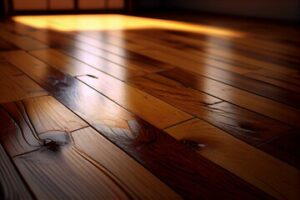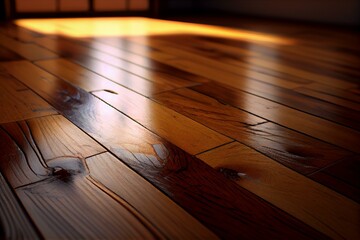Hardwood floors add a warm, welcoming touch to your home. They also help reduce the amount of dust and allergens in your house. Refinishing or resealing your hardwood floors will protect them and prolong their life.
Resurfacing is a cheaper option and ideal for homeowners on a budget who don’t mind a less glossy finish. This is not a project for the amateur homeowner, however. For professional help, contact Hardwood Floor Refinishing Bergen County NJ now!
Hardwood floors look great in any setting and can really add a feeling of warmth and luxury to a room. However, they aren’t cheap and they do require a lot of work to maintain. The good news is that there are a variety of options available to homeowners who want to save some money on the hardwood floor refinishing process and save some time as well.
One option is to recoat instead of refinishing. Recoating is a simpler and cheaper process that involves applying a new coat of finish over the existing layer without removing it entirely. This is ideal for hardwood floors that are still in good shape and only have minor scratches and dents on the finish surface, but not on the wood itself.
Before sanding, it’s important to completely clean the floor. Sweeping and vacuuming is a good start, but a damp mop should also be used to make sure all dust particles are removed from the floor before sanding. In addition, it’s a good idea to remove any baseboards and pull up shoe molding along the wall-floor joint. This will ensure that the sanding machine doesn’t leave marks on these areas.
Once the floor is swept and vacuumed, it should be wiped down using a tack cloth, which is a wax-impregnated piece of cheesecloth designed to pick up and hold dust residue. It’s also a good idea to take this opportunity to inspect the floor for any damage or gouges that need to be repaired.
After the floor has been sanded, it should be wiped down again with a tack cloth and allowed to dry completely. In the meantime, it’s a good idea to put plastic sheeting over doors and any floor registers that can’t be moved, in order to prevent dust from migrating into other parts of the house.
It’s also a good idea to wear ear protection and a face mask if using a power sanding machine, as the sanding process can be quite noisy. Eye protection is also recommended, since it’s not uncommon to get peppery wood dust in the eyes during sanding.
Staining
Staining is arguably the most important step in refinishing hardwood floors. It gives the wood its color, accentuates the grain, and provides a finished look that will make the entire project worth your time. That said, staining can also be one of the most difficult. A single mistake can ruin the whole floor, so it’s crucial to understand what can go wrong and how to avoid it.
The first step is to choose a color that matches your walls and furniture. Once you’ve chosen the right shade, apply a coat of oil-based or water-based wood stain. Allow the stain to dry according to the manufacturer’s instructions, which can range from a few hours to overnight. Keep in mind that additional coats may be necessary to achieve the desired color.
If you’re using an oil-based stain, be sure to use a respirator mask and proper ventilation. Oil-based stains can take longer to dry than water-based stains and can emit strong fumes. It’s also a good idea to test the stain on an inconspicuous part of the floor before applying it to the entire area.
Before staining, thoroughly vacuum the floor to remove any dust particles that might remain from the sanding process. It’s best to do this before starting any work as a dirty floor will have an adverse effect on the outcome of the stain.
Another important thing to remember is to stir the stain thoroughly before each application. Different liquids might contain slightly different pigments, and if they don’t mix evenly, you could end up with an uneven color on the floor. You can also try a technique called “water popping” to help your stain look its best.
It might seem obvious, but it’s worth reminding everyone that staining is messy. It’s a good idea to wear rubber gloves and use a dust mask while working. You’ll also want to put on a pair of safety glasses in case any stain gets in your eyes. If you’re hiring a professional to do the staining, be sure to tell him or her that you want the job to be done properly. This is especially important if you’re using an oil-based stain, which requires more attention to detail than water-based stain.
Sealing
A hardwood floor’s top coat, or finish, protects the wood from moisture and provides a degree of shine. The finish can be as simple as a wax coating or as substantial as an oil-based polyurethane. The choice of finish depends on your personal taste, the amount of foot traffic, and the level of protection you desire.
A new finish will also help mask dents, scratches, and discolorations that may have occurred over time. Refinishing will give your floors a clean and fresh look that is in stark contrast to worn carpets or old vinyl tiles.
When choosing a contractor, consider their experience and references. Refinishing is a labor-intensive job and mistakes can be costly. Hiring a professional with the proper training and equipment is often a wise investment, especially for homeowners who are not comfortable doing the work themselves.
Before starting the refinishing process, remove all furniture and fixtures from the room. Vacuum and sweep the floor thoroughly to remove dust and debris. Once the room is clean, sand the floor using a drum or orbital sander, starting with coarse-grit paper and working progressively finer. When the sanding is complete, clean the floor again and vacuum and sweep it.
During the staining process, it is important to keep in mind that the color of your hardwood can change due to natural variations in the wood itself and the chemical strippers used to remove the old finish. For this reason, it is always a good idea to have multiple samples of your chosen color in front of you when you start the refinishing process.
Once the stains have dried, you can apply the final layer of finish. Traditionally, this was done with wax but in recent years oil-based polyurethane has become the norm.
When choosing a polyurethane, be sure to read the label carefully. Some products have specific requirements for curing times and temperature, and others are sensitive to humidity. A quality polyurethane will provide a durable finish that will stand up to heavy foot traffic and resist fading and discoloration. Whether you choose an oil-based or water-based product, be sure to open a window and ventilate the area when applying it.
Cleaning
A well-maintained hardwood floor is easy to keep clean, but if it isn’t properly cared for, stains and scratches can set in. Whether your floors are in need of major repair or just need a little help to look their best, you can help them by implementing a regular cleaning routine, using the right products and techniques.
Before you get started, it’s important to know whether your floors are sealed. Water-based cleaners can damage unfinished or unsealed wood, so if your floors aren’t sealed, be sure to use only oil-based cleaning solutions. You can test your floors’ sealant by pouring a small amount of water onto them. If the water beads up and doesn’t soak into the surface, your floors are sealed; however, if the water does seep into the wood, it is time to re-seal them.
Start by sweeping the floors to remove dust and debris. Use a broom with soft bristles, as hard-bristled brushes can scratch and dull your floors’ surface. Once you’ve swept, vacuum the hardwood floors to remove dirt and other debris trapped in the cracks of your floors.
Next, wipe down your hardwood floors with a damp cloth or mop. Use a gentle, mild cleanser to avoid damaging your floor’s surface, and always wipe in the direction of the wood grain. After wiping, dry your floors with a towel and apply a floor wax that is specifically made for wood, such as a solvent-based Trewax Paste Wax or similar product.
Paint splatters and drips happen; however, most can be removed from hardwood floors with a little elbow grease and the right cleaning products. First, determine whether the paint is water-based or oil-based. If it is water-based, mix a solution of 1 cup of vinegar to 1 gallon of warm water and scrub the spot with a microfiber rag. Be sure to use a rag that is only slightly damp, as excess moisture can cause the wood to warp and buckle.
